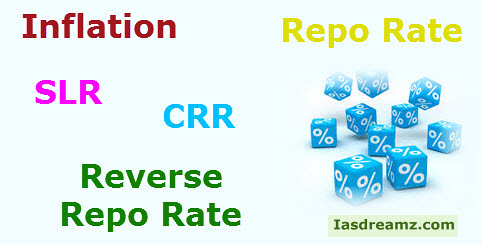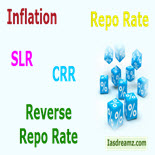In this article, we will briefly discuss the concept of Inflation, Repo Rate, Reverses Repo Rate, Cash Reverse Ratio (CRR) and Statutory liquidity ratio (SLR). This will help you to form a basic fundamental of some of the terms in economics. Understanding the below basic concepts will help you a lot in your Prelims exams (CSAT- Paper 1) as well as other competitive exams covering these topics.
Inflation
Inflation is defined as the rise in the price of the goods and services on a generic level. This rise in price is quite substantial as you need to pay more amount of money for goods and services (that were available before at a cheaper price).
With increase in inflation, the purchasing power of money decreases. On the contrary, with a declining inflation, the purchasing power increases.
Causes of inflation:
Inflation can be caused by any of the below factors:
1. If there is lesser number of goods/services available and more demand for it i.e. the demand is more than the supply.
2. If big businesses and industries increases the price of their goods and services to gain more profit margin.
3. When the basic products and services increase their price on which there is lot of dependency on other goods like oil and petroleum.
4. Bad monetary policy taken up by the government of an economy.
5. Low investment and savings.
Methods to Control Inflation:
- By controlling the interest rates. A higher rate of interest implemented by the central bank reduces the supply of money in the economy.
- Government can increase taxes (such as income tax and VAT) and cut spending.
- Reducing the growth of Aggregate demand.
- Export restrictions which would be a crackdown on hoarding of goods.
- A higher interest rate should also lead to higher valuation of the currency, which helps to reduce inflationary pressure by making imports cheaper and reducing demand for exports.
Inflation sometimes does mean that the economy is growing. However, Inflation does not always indicate growth of money for an economy.

Repo Rate:
It is the rate at which the central bank of a country will lend money to commercial banks in case of deficit of funds.
Central Bank in case of India is the RBI (not Central Bank of India).
Repo rate can be used to control inflation. How?
If central bank increases the repo rate, banks would be discouraged to borrow money from the central bank. Thus, they will try to limit their borrowing which will reduce the supply of money in the economy and thus control inflation. On the contrary, central bank will decrease the repo rate to induce more supply of money in the economy.
Reverses Repo Rate:
Reverse repo rate is the rate at which the central bank of a country lends money from commercial banks within the country.
It can be used to control the supply of money in an economy. How?
If there is an increase in the reverse repo rate, banks will park more money with RBI, thereby decreasing the supply of money in the economy. On the contrary, a low reverse repo rate will discourage the banks from parking their money and thus increase the supply of money in the economy.
Cash Reverse Ratio (CRR)
Cash Reserve Ratio is a specified minimum fraction of the total deposits of customers, which commercial banks have to park with the central bank either in the form of cash or deposits.
Cash Reserves are a good way to maintain financial stability of banks. Thus, in situations when the bank goes bankrupt, the RBI would have this parked money through which it could make payments to its depositors.
For instance, if there are no cash reserves with RBI, then commercial banks should have to achieve the status of zero non-performing assets along with a satisfactory level of investment risk reserves in order to protect the depositors in a financial breakdown.
CRR is a crucial monetary policy tool and is used for controlling money supply in an economy as it induces the banking system to adjust its deposits liabilities to its actual reserves more rapidly within each reserve maintenance period. If the CRR is increased by the RBI, bank will have to park more money and thus it will reduce the supply of money in the economy and vice versa.
Statutory liquidity ratio (SLR)
Statutory liquidity ratio (SLR) refers to the amount that the commercial banks should maintain in the form of cash, gold or other approved securities (bonds, shares of companies, etc.) before providing credit to its customers. It is regulated by RBI in order to prevent over-credit by the banks.
SLR is usually imposed on bank to limit their credit expansion so that they do not run out of money while paying back to their customers.
SLR control inflation and supply of money. An increase in SLR reduces the supply of money and thus helps in combating inflation and vice versa.
